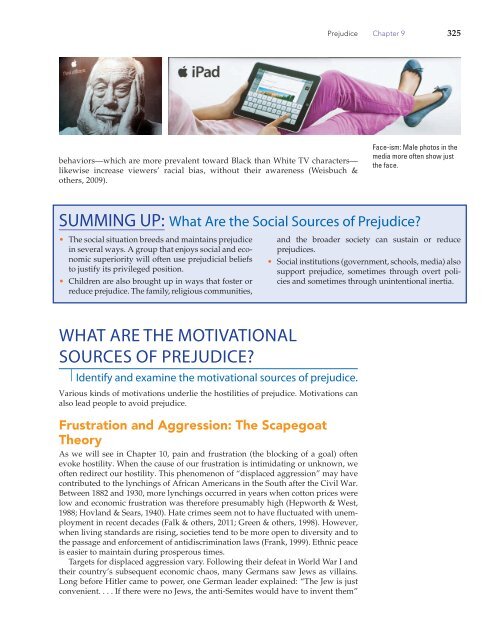Chapter 9: Prejudice: Disliking Others (2947.0K) - Bad Request
Chapter 9: Prejudice: Disliking Others (2947.0K) - Bad Request
Chapter 9: Prejudice: Disliking Others (2947.0K) - Bad Request
You also want an ePaper? Increase the reach of your titles
YUMPU automatically turns print PDFs into web optimized ePapers that Google loves.
ehaviors—which are more prevalent toward Black than White TV characters—<br />
likewise increase viewers’ racial bias, without their awareness (Weisbuch &<br />
others, 2009).<br />
SUMMING UP:<br />
• The social situation breeds and maintains prejudice<br />
in several ways. A group that enjoys social and economic<br />
superiority will often use prejudicial beliefs<br />
to justify its privileged position.<br />
• Children are also brought up in ways that foster or<br />
reduce prejudice. The family, religious communities,<br />
<strong>Prejudice</strong> <strong>Chapter</strong> 9 325<br />
Face-ism: Male photos in the<br />
media more often show just<br />
the face.<br />
What Are the Social Sources of <strong>Prejudice</strong>?<br />
WHAT ARE THE MOTIVATIONAL<br />
SOURCES OF PREJUDICE?<br />
Identify and examine the motivational sources of prejudice.<br />
Various kinds of motivations underlie the hostilities of prejudice. Motivations can<br />
also lead people to avoid prejudice.<br />
Frustration and Aggression: The Scapegoat<br />
Theory<br />
As we will see in <strong>Chapter</strong> 10, pain and frustration (the blocking of a goal) often<br />
evoke hostility. When the cause of our frustration is intimidating or unknown, we<br />
often redirect our hostility. This phenomenon of “displaced aggression” may have<br />
contributed to the lynchings of African Americans in the South after the Civil War.<br />
Between 1882 and 1930, more lynchings occurred in years when cotton prices were<br />
low and economic frustration was therefore presumably high (Hepworth & West,<br />
1988; Hovland & Sears, 1940). Hate crimes seem not to have fluctuated with unemployment<br />
in recent decades (Falk & others, 2011; Green & others, 1998). However,<br />
when living standards are rising, societies tend to be more open to diversity and to<br />
the passage and enforcement of antidiscrimination laws (Frank, 1999). Ethnic peace<br />
is easier to maintain during prosperous times.<br />
Targets for displaced aggression vary. Following their defeat in World War I and<br />
their country’s subsequent economic chaos, many Germans saw Jews as villains.<br />
Long before Hitler came to power, one German leader explained: “The Jew is just<br />
convenient. . . . If there were no Jews, the anti-Semites would have to invent them”<br />
and the broader society can sustain or reduce<br />
prejudices.<br />
• Social institutions (government, schools, media) also<br />
support prejudice, sometimes through overt policies<br />
and sometimes through unintentional inertia.

















